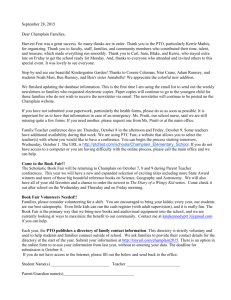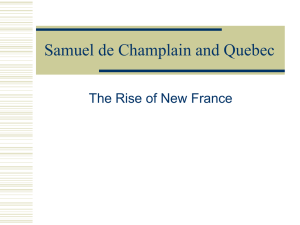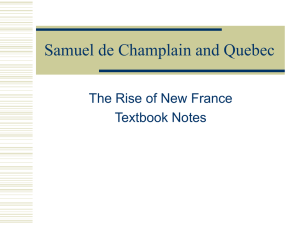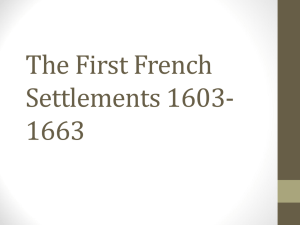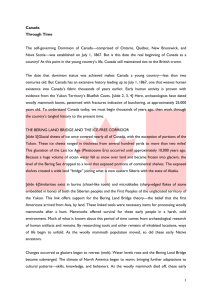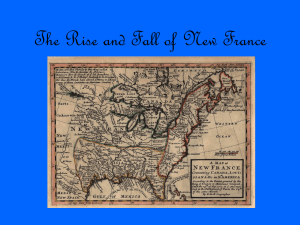Port Royal
advertisement
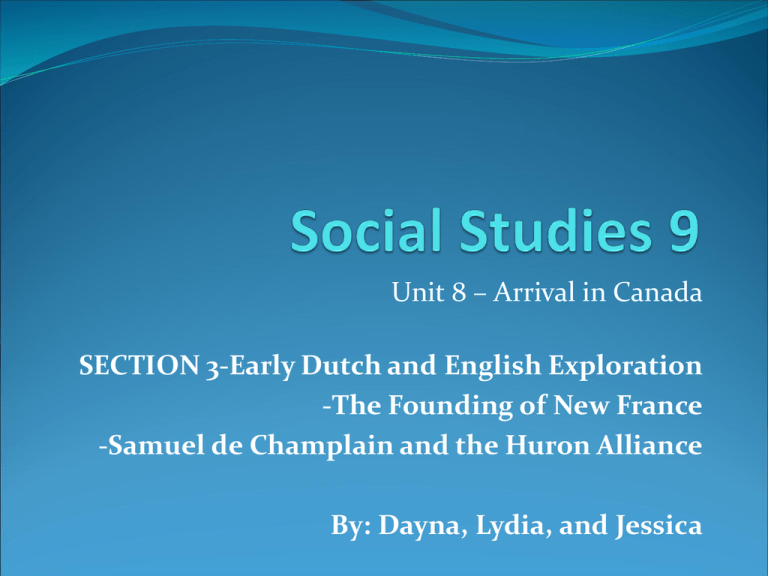
Unit 8 – Arrival in Canada SECTION 3-Early Dutch and English Exploration -The Founding of New France -Samuel de Champlain and the Huron Alliance By: Dayna, Lydia, and Jessica Settlement on the Hudson River In 1610 the Dutch settled on the Hudson River. They controlled the Hudson River Valley from 1609 until the English took over in 1664. During this time, the Dutch made a series of trading posts, towns, and forts up and down the Hudson River. Company for Exploration The Dutch East India Company was a chartered company established in 1602. The States-General of the Netherlands granted it a 21year monopoly to carry out colonial activities in Asia. Dutch Colony The first Dutch settlement in America was founded in 1614. It was called Fort Nassau, on Castle Island in the Hudson, near present-day Albany. It was later replaced by Fort Orange. Both forts were named in honor of the Dutch House of Orange-Nassau. English Explorers Sir Martin Frobisher was an English seaman who made three voyages to the New World to look for the North Passage. All his voyages landed in northeastern Canada, around today's Resolution Island and Frobisher Bay. He lived from 1535– 15 November 1594. English Explorers William Baffin (died 23 January 1622) was an English navigator and explorer. Nothing is known of his early life, but it is a guess that he was born in London. William Baffin explored the Arctic Circle. In 1615, he entered the service of the Company for the discovery of the Northwest Passage, and explored the Hudson Strait. English Explorers John Davis (1550 - 1605), was one of the chief English navigators and explorers. From a boy he was a sailor, and early went on voyages with his close neighbor. English Explorers Sir Humphrey Gilbert was from Devon in England. He was an Adventurer, explorer, member of Parliament, and soldier. Sir Humphrey Gilbert arrives at Newfoundland and claims it in the name of the Crown. On September 9,1583, Sir Humphrey Gilbert drowns at sea on his journey home. Sea Dogs The Sea Dogs were English adventurers or pirates. They were active from 1560 to 1605. John Hawkins was the leader of the Sea Dogs. The Founding of New France On his third trip in 1608, Champlain founded a settlement and trading post along the St. Lawrence River that eventually became the city of Quebec. It was the first permanent white settlement in Canada, which makes Quebec the oldest city in Canada. Port Royal Port Royal was founded by Pierre Dugua, Sieur de Mons and Samuel de Champlain in 1605. Port Royal was once the capital of Acadia and is now a small community in the province of Nova Scotia. Initially Port Royal was placed on the north shore of the Annapolis Basin, Nova Scotia. Port Royal •As a port city, it was homeport for the English and Dutch privateers to spend their treasure. •When governments stopped issuing letters against the Spanish possessions, many privateers turned pirate and used the city as their main base. •Pirates from around the world congregated at Port Royal coming from waters as far away as Madagascar. Port Royal After the disaster in 1692, Port Royal's commercial role was steadily taken over by the town of Kingston. Plans for Port Royal redeveloped the small fishing town into a tourist destination. Order of Good Cheer •The Order of Good Cheer was originally a French Colonial Order founded by Samuel de Champlain upon arrival in New France. •You can become a member of the Order of Good Cheer by receiving an invitation of the Canadian Province of Nova Scotia or by a Member of the Order. Samuel De Champlain •Is a European explorer •Explorer of North America •He discovered New France on July 3, 1608 •Born in the year 1567 •Died on December 25, 1635 Samuel De Champlain Samuel De Champlain •Acadia was a colony that was formed by the French immigrants . •In 1608 Samuel de Champlain led another expedition because he wanted to start a new French colony on the shores of the St. Lawrence. This is how he found New France. •He chose Quebec for New France because it was full of vegetation and it had good fertile land. Samuel’s Accomplishments •He was the first explorer to explore and describe the great lakes. •He published maps and wrote about his experiences with the Natives. •He formed relationships with local Montagnais and Innu and later with Algonquin and Huron. He agreed to provide assistance in their wars against the Iroquois. • He established trading companies that sent goods, primarily fur, to France. Sieur de Monts •Also known as Pierre Du Gua de Monts •Was a French merchant, explorer and colonizer •Born in Ryan, France •In 1603,the King of France, granted Du Gua exclusive right to colonize lands in North America. •Henry IV appointed Sieur de Monts Governor over the Protestant city of Pons CharenteMaritime from 1610 to 1617, then he retired. •He died in 1628, in the nearby castle of Ardenne in Fleac-Sur-Seugne. Algonquians •Before Europeans came into contact, most Algonquian settlements lived by hunting and fishing, also ate corn, beans, squash, and wild rice. •American Indians lived in an area extending from Labrador to the Rocky Mountains, through Michigan and Illinois, and along the Atlantic coast to Cape Hatteras. Montagnais • A group of closely related Algonquian tribes in Canada. • Extending from about St Maurice River almost to the Atlantic, and from the St Lawrence to the watershed of Hudson Bay. • Their population is originally, about 10,000. •Currently, there are almost 13,000 Montagnais in Quebec with another 800 living in Labrador. Hurons (Wyandot) The Huron ate food that they grew such as maize. They also ate fish, deer meat, wild nuts and berries and maple syrup. Women did most of the agricultural work, although men helped in the heaviest work of clearing the fields. Men did most of the fishing and hunting, and constructed the houses, canoes, and tools. Hurons (Wyandot) They lived in long houses, the typical village had 900 to 1600 people organized into 30 or 40 longhouses. The total population of the Huron at the time of European contact has been estimated at about 20,000 to 40,000 people. Hurons (Wyandot) The 3 main economic advantages the Hurons had were: 1. There were lots of networks of rivers and lakes so they could use canoes to travel. 2. Lived in the middle of everything, like tribes which were great for trade and other things. 3. Had advantage over the French because of their location. Huron Alliance During the summer of 1609, Champlain made alliances with the Wyandot. A coureur de bois was an adventurer, expert canoeist, and skilled businessman, (Runner of the Woods). In 1608 Champlain took Etienne Brûléon board, a 16 year old, to be his servant (coureur de bois). In 1610, Champlain arranged an exchange with the Hurons. Brûlé would live with the Hurons, integrate himself, learn the language and customs, and literally become a native. Trade Castor gras d'hiver was the most prized pre-conditioned beaver hide. Beaver fur was the most valuable and was used to make hats. The Indians traded furs for tools and weapons. Also Indian Knives and kettles were exchanged for beaver, fox, marten, mink and otter. Settlements He returned to France in 1607, and, established a tradingpost on the St. Lawrence but there was a plot to assassinate him. At Quebec he erected houses, sowed grain, and did all he could to develop the fur trade, and in a short time the settlement began to grow. Settlements Kirke Brothers and Cardinal Richelieu Kirke and his brothers captured tadoussac in 1628, demanding that Champlain surrender to Quebec, but he refused. Cardinal Richelieu was a French Clergyman, Noble, and statesman. Also an advocate for Champlain. He saw the Treaty of Saint-Germain-en-Laye return Quebec City to French rule under Champlain. Champlain's Death Champlain suffered a severe stroke in October 1635, and died on 25 December 1635, leaving no immediate heirs. He explored Canada because King Henry had sent him.


